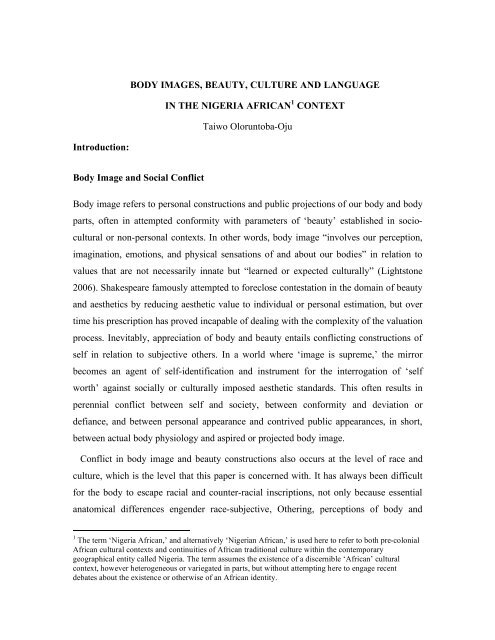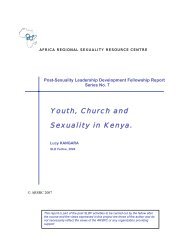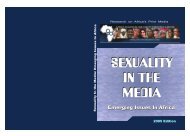body images beauty culture and language - Africa Regional ...
body images beauty culture and language - Africa Regional ...
body images beauty culture and language - Africa Regional ...
Create successful ePaper yourself
Turn your PDF publications into a flip-book with our unique Google optimized e-Paper software.
Introduction:<br />
BODY IMAGES, BEAUTY, CULTURE AND LANGUAGE<br />
Body Image <strong>and</strong> Social Conflict<br />
IN THE NIGERIA AFRICAN 1 CONTEXT<br />
Taiwo Oloruntoba-Oju<br />
Body image refers to personal constructions <strong>and</strong> public projections of our <strong>body</strong> <strong>and</strong> <strong>body</strong><br />
parts, often in attempted conformity with parameters of ‘<strong>beauty</strong>’ established in socio-<br />
cultural or non-personal contexts. In other words, <strong>body</strong> image “involves our perception,<br />
imagination, emotions, <strong>and</strong> physical sensations of <strong>and</strong> about our bodies” in relation to<br />
values that are not necessarily innate but “learned or expected culturally” (Lightstone<br />
2006). Shakespeare famously attempted to foreclose contestation in the domain of <strong>beauty</strong><br />
<strong>and</strong> aesthetics by reducing aesthetic value to individual or personal estimation, but over<br />
time his prescription has proved incapable of dealing with the complexity of the valuation<br />
process. Inevitably, appreciation of <strong>body</strong> <strong>and</strong> <strong>beauty</strong> entails conflicting constructions of<br />
self in relation to subjective others. In a world where ‘image is supreme,’ the mirror<br />
becomes an agent of self-identification <strong>and</strong> instrument for the interrogation of ‘self<br />
worth’ against socially or culturally imposed aesthetic st<strong>and</strong>ards. This often results in<br />
perennial conflict between self <strong>and</strong> society, between conformity <strong>and</strong> deviation or<br />
defiance, <strong>and</strong> between personal appearance <strong>and</strong> contrived public appearances, in short,<br />
between actual <strong>body</strong> physiology <strong>and</strong> aspired or projected <strong>body</strong> image.<br />
Conflict in <strong>body</strong> image <strong>and</strong> <strong>beauty</strong> constructions also occurs at the level of race <strong>and</strong><br />
<strong>culture</strong>, which is the level that this paper is concerned with. It has always been difficult<br />
for the <strong>body</strong> to escape racial <strong>and</strong> counter-racial inscriptions, not only because essential<br />
anatomical differences engender race-subjective, Othering, perceptions of <strong>body</strong> <strong>and</strong><br />
1 The term ‘Nigeria <strong>Africa</strong>n,’ <strong>and</strong> alternatively ‘Nigerian <strong>Africa</strong>n,’ is used here to refer to both pre-colonial<br />
<strong>Africa</strong>n cultural contexts <strong>and</strong> continuities of <strong>Africa</strong>n traditional <strong>culture</strong> within the contemporary<br />
geographical entity called Nigeria. The term assumes the existence of a discernible ‘<strong>Africa</strong>n’ cultural<br />
context, however heterogeneous or variegated in parts, but without attempting here to engage recent<br />
debates about the existence or otherwise of an <strong>Africa</strong>n identity.






